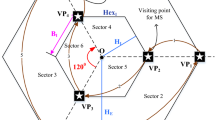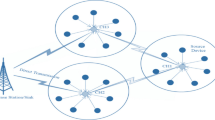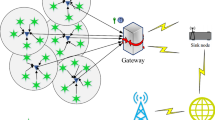Abstract
Data Aggregation for IoT-WSN, based on Machine Learning (ML), allows the Internet of Things (IoT) and Wireless Sensor Networks (WSN) to send accurate data to the trusted nodes. The existing work handles the dropouts well but is vulnerable to different attacks. In the proposed research work, the Data Aggregation (DA) based on Machine Learning (ML) fails the untrusted aggregator nodes. In the attack scenario, this paper proposes a Machine Learning Based Data Aggregation and Routing Protocol (MLBDARP) that verifies the network nodes and DA functions based on ML. This work is to authenticate the nodes to support the MLBDARP, a novel secret shared authentication protocol, and then aggregate using a secure protocol. MLBDARP types of the ML algorithm, such as Decision Trees (DT) and Neural Networks (NN). ML helps determine the probability of a successful Packet Delivery Ratio (PDR). This proposed ML model uses predictability value, Energy Consumption (EC), mobility, and node position. Simulation results proved that the proposed protocol of MLBDARP outperforms Differentiated Data Aggregation Routing Protocol (DDARP) and Weighted Data Aggregation Routing Protocol (WDARP) with Quality of Service (QoS) parameters of Network Throughput (NT), Routing Overhead (RO), End-to-End Delay (EED), Packet Delivery Ratio (PDR) and Energy Consumption (EC).



























Similar content being viewed by others

Availability of Data and Material
Not applicable.
Code Availability
Not Applicable.
References
Hunt, T., Song, C., Shokri, R., Shmatikov, V., & Witchel, E. (2018). “Chiron: Privacy-preserving Machine Learning as a Service,” arXiv, Mar. 2018, Accessed: May 11, 2021. [Online]. Available: http://arxiv.org/abs/1803.05961.
Nie, J., Luo, J., Xiong, Z., Niyato, D., & Wang, P. (2019). A stackelberg game approach toward socially-aware incentive mechanisms for mobile crowdsensing. IEEE Transactions on Wireless Communications, 18(1), 724–738. https://doi.org/10.1109/TWC.2018.2885747
Wang, Z., Song, M., Zhang, Z., Song, Y., Wang, Q. & Qi, H. (2018). “Beyond inferring class representatives: user-level privacy leakage from federated learning,” in Proceedings - IEEE INFOCOM, vol. 2019-April, pp. 2512–2520, Dec. 2018, Accessed: May 11, 2021. [Online]. Available: http://arxiv.org/abs/1812.00535.
Atapattu, S., Ross, N., Jing, Y., He, Y., & Evans, J. S. (2019). Physical-layer security in full-duplex multi-hop multi-user wireless network with relay selection. IEEE Transactions on Wireless Communications, 18(2), 1216–1232. https://doi.org/10.1109/TWC.2018.2890609
Liu, Z., Guo, J., Lam, K.-Y., & Zhao, J. (2022). Efficient dropout-resilient aggregation for privacy-preserving machine learning. IEEE Transactions on Information Forensics and Security. https://doi.org/10.1109/TIFS.2022.3163592
Liao, X., Zhang, Y., Wu, Z., Shen, Y., Jiang, X., & Inamura, H. (2018). On security-delay trade-off in two-hop wireless networks with buffer-aided relay selection. IEEE Transactions on Wireless Communications, 17(3), 1893–1906. https://doi.org/10.1109/TWC.2017.2786258
Wang, Q., Zhang, Y., Lu, X., Wang, Z., Qin, Z., & Ren, K. (2018). Real-time and spatio-temporal crowd-sourced social network data publishing with differential privacy. IEEE Transactions on Dependable and Secure Computing, 15(4), 591–606. https://doi.org/10.1109/TDSC.2016.2599873
Wang, Z., et al. (2019). Personalized privacy-preserving task allocation for mobile crowdsensing. IEEE Transactions on Mobile Computing, 18(6), 1330–1341. https://doi.org/10.1109/TMC.2018.2861393
Wang, Z., et al. (2019). Privacy-preserving crowd-sourced statistical data publishing with an untrusted server. IEEE Transactions on Mobile Computing, 18(6), 1356–1367. https://doi.org/10.1109/TMC.2018.2861765
Niu, C., Wu, F., Tang, S., Ma, S., & Chen, G. (2022). Toward verifiable and privacy-preserving machine learning prediction. IEEE Transactions on Dependable and Secure Computing, 19(3), 1703–1721. https://doi.org/10.1109/TDSC.2020.3035591
Yuan, D., Li, Q., Li, G., Wang, Q., & Ren, K. (2020). PriRadar: A privacy-preserving framework for spatial crowdsourcing. IEEE Transactions on Information Forensics and Security, 15, 299–314. https://doi.org/10.1109/TIFS.2019.2913232
Kittur, L. J., & Pais, A. R. (2023). Combinatorial design based key pre-distribution scheme with high scalability and minimal storage for wireless sensor networks. Wireless Personal Communications, 128, 855–873. https://doi.org/10.1007/s11277-022-09979-2
Elangovan, G. R., & Kumanan, T. (2023). Energy efficient and delay aware optimization reverse routing strategy for forecasting link quality in wireless sensor networks. Wireless Personal Communications, 128, 923–942. https://doi.org/10.1007/s11277-022-09982-7
Wang, Z., et al. (2019). When mobile crowdsensing meets privacy. IEEE Communications Magazine, 57(9), 72–78. https://doi.org/10.1109/MCOM.001.1800674
Butt, U. A., Amin, R., Mehmood, M., et al. (2023). Cloud security threats and solutions: A survey. Wireless Personal Communications, 128, 387–413. https://doi.org/10.1007/s11277-022-09960-z
“Apple’s ‘Differential Privacy’ Is About Collecting Your Data---But Not Your Data | WIRED.” https://www.wired.com/2016/06/apples-differential-privacy-collecting-data/ (accessed May 12, 2021).
Kaliyaperumal, K., Sammy, F. (2022). An efficient key generation scheme for secure sharing of patients health records using attribute-based encryption, in 2022 International Conference on communication, computing and internet of things (IC3IoT), Chennai, India, pp. 1–6, https://doi.org/10.1109/IC3IOT53935.2022.9767726.
Dwork, C., Lei, J. (2009). Differential privacy and robust statistics, in Proceedings of the annual ACM symposium on theory of computing, pp. 371–380, https://doi.org/10.1145/1536414.1536466.
Alghamdi, W., Rezvani, M., Wu, H., & Kanhere, S. S. (2019). Routing-aware and malicious node detection in a concealed data aggregation for WSNs. ACM Transactions on Sensor Networks. https://doi.org/10.1145/3293537
Araki, T., Furukawa, J., Lindell, Y., Nof, A. & Ohara, K. (2016). High-throughput semi-honest secure three-party computation with an honest majority, in Proceedings of the ACM conference on computer and communications security, vol. 24–28, pp. 805–817, https://doi.org/10.1145/2976749.2978331.
Nandakumar, K., Vinod, V., Batcha, S. M. A., Sharma, D. K., Elangovan, M., Poonia, A., Basavaraju, S. M., Dogiwal, S. R., Dadheech, P., & Sengan, S. (2021). Securing data in transit using data-in-transit defender architecture for cloud communication. Soft Computing. https://doi.org/10.1007/s00500-021-05928-6
Corrigan-Gibbs, H., Wolinsky, D.I. & Ford, B. (2012). Proactively accountable anonymous messaging in verdict, in Proceedings of the 22nd USENIX security symposium, pp. 147–162, Accessed: May 12, 2021. [Online]. Available: http://arxiv.org/abs/1209.4819.
Li, X., Liu, S., Wu, F., Kumari, S., & Rodrigues, J. J. P. C. (2019). Privacy-preserving data aggregation scheme for mobile edge computing assisted IoT applications. IEEE Internet of Things Journal, 6(3), 4755–4763. https://doi.org/10.1109/JIOT.2018.2874473
Liu, Y. N., Wang, Y. P., Wang, X. F., Xia, Z., & Xu, J. F. (2019). Privacy-preserving raw data collection without a trusted authority for IoT. Computer Networks, 148, 340–348. https://doi.org/10.1016/j.comnet.2018.11.028
Abdallah, A., & Shen, X. (2018). A lightweight lattice-based homomorphic privacy-preserving data aggregation scheme for smart grid. IEEE Transactions on Smart Grid, 9(1), 396–405. https://doi.org/10.1109/TSG.2016.2553647
Chan, T.H.H., Shi, E. & Song, D. (2012). Privacy-preserving stream aggregation with fault tolerance, in Lecture notes in computer science (including subseries lecture notes in artificial intelligence and lecture notes in bioinformatics), vol. 7397 LNCS, pp. 200–214, https://doi.org/10.1007/978-3-642-32946-3_15.
Chen, Y., Martinez-Ortega, J. F., Castillejo, P., & Lopez, L. (2019). A homomorphic-based multiple data aggregation scheme for smart grid. IEEE Sensors Journal, 19(10), 3921–3929. https://doi.org/10.1109/JSEN.2019.2895769
Li, S., Xue, K., Yang, Q., & Hong, P. (2018). PPMA: Privacy-preserving multisubset data aggregation in smart grid. IEEE Transactions on Industrial Informatics, 14(2), 462–471. https://doi.org/10.1109/TII.2017.2721542
Liu, Y., Guo, W., Fan, C. I., Chang, L., & Cheng, C. (2019). A practical privacy-preserving data aggregation (3PDA) scheme for smart grid. IEEE Transactions on Industrial Informatics, 15(3), 1767–1774. https://doi.org/10.1109/TII.2018.2809672
Kserawi, F., Al-Marri, S., & Malluhi, Q. (2022). Privacy-Preserving fog aggregation of smart grid data using dynamic differentially-private data perturbation. IEEE Access, 10, 43159–43174. https://doi.org/10.1109/ACCESS.2022.3167015
Wu, H., Wang, L., & Xue, G. (2020). Privacy-aware task allocation and data aggregation in fog-assisted spatial crowdsourcing. IEEE Transactions on Network Science and Engineering, 7(1), 589–602. https://doi.org/10.1109/TNSE.2019.2892583
Zhang, X., Wang, W., Mu, L., et al. (2021). Efficient privacy-preserving anonymous authentication protocol for vehicular ad-hoc networks. Wireless Personal Communications, 120, 3171–3187. https://doi.org/10.1007/s11277-021-08605-x
Jegadeesan, S., Obaidat, M. S., Vijayakumar, P., et al. (2022). Efficient privacy-preserving anonymous authentication scheme for human predictive online education system. Cluster Comput, 25, 2557–2571. https://doi.org/10.1007/s10586-021-03390-5
Li, X., et al. (2018). Differentiated data aggregation routing scheme for energy conserving and delay-sensitive wireless sensor networks. Sensors (Switzerland). https://doi.org/10.3390/s18072349
Zhang, R., Shi, J., Zhang, Y., & Zhang, C. (2013). Verifiable privacy-preserving aggregation in people-centric urban sensing systems. IEEE Journal on Selected Areas in Communications, 31(9), 268–278. https://doi.org/10.1109/JSAC.2013.SUP.0513024
Nanthini, S., Kalyani, S. N., & Sengan, S. (2021). Energy-efficient clustering protocol to enhance network lifetime in wireless sensor networks. Computers, Materials and Continua, 68(3), 3595–3614. https://doi.org/10.32604/CMC.2021.015038
Thiagarajan, A. et al. (20009) VTrack: Accurate, energy-aware road traffic delay estimation using mobile phones, in Proceedings of the 7th ACM conference on embedded networked sensor systems, SenSys 2009, pp. 85–98, https://doi.org/10.1145/1644038.1644048.
Huang, T.K., Lee, C.K. & Chen, L.J. (2010). PRoPHET+: An adaptive PRoPHET-based routing protocol for opportunistic network, in Proceedings - international conference on advanced information networking and applications, AINA, pp. 112–119, DOI: https://doi.org/10.1109/AINA.2010.162.
Lindell, Y., Pinkas, B., Smart, N. P., & Yanai, A. (2019). Efficient constant-round multi-party computation combining BMR and SPDZ. Journal of Cryptology, 32(3), 1026–1069. https://doi.org/10.1007/s00145-019-09322-2
Sheikh, R. & Mishra, D.K. (2019). Secure sum computation using homomorphic encryption, in Lecture notes on data engineering and communications technologies, vol. 16, Springer Science and Business Media Deutschland GmbH, pp. 357–363.
von Maltitz, M., Bitzer, D. & Carle, G. (2019). Data querying and access control for secure multiparty computation, in 2019 IFIP/IEEE symposium on integrated network and service management, IM 2019, pp. 171–179, Accessed: May 12, 2021. [Online]. Available: http://arxiv.org/abs/1901.02651.
Mödinger, D., Hauck, F.J. (2020). 3P3: Strong Flexible privacy for broadcasts, in 2020 IEEE 19th international conference on trust, security and privacy in computing and communications (TrustCom), Guangzhou, China, pp. 1630–1637, https://doi.org/10.1109/TrustCom50675.2020.00225.
Narayanasami, S., Sengan, S., Khurram, S., Arslan, F., Murugaiyan, S. K., Rajan, R., Peroumal, V., Dubey, A. K., Srinivasan, S., & Sharma, D. K. (2021). Biological feature selection and classification techniques for intrusion detection on BAT. Wireless Personal Communications. https://doi.org/10.1007/s11277-021-08721-8
Rayati, M., Bozorg, M. (2022). Pricing differentially private smart meter data in distribution networks, im 18th International conference on the European Energy Market (EEM), Ljubljana, Slovenia, pp. 1–6, https://doi.org/10.1109/EEM54602.2022.9921095.
Jansen, R., Johnson, A. (2021). Safely Measuring Tor, Accessed: May 12, 2021. [Online]. Available: https://doi.org/10.1145/2976749.2978310.
Vahdat, A., Vahdat, A. & Becker, D. (2021). “Epidemic Routing for Partially-Connected Ad Hoc Networks,” 2000, Accessed: May 12, 2021. [Online]. Available: http://citeseerx.ist.psu.edu/viewdoc/summary?doi=10.1.1.34.6151.
Boldrini, C., Conti, M., Iacopini, I. & Passarella, A. (2007). HiBOp: A history-based routing protocol for opportunistic networks, https://doi.org/10.1109/WOWMOM.2007.4351716.
Dhurandher, S.K., Sharma, D.K., Woungang, I. & Bhati, S. (2013). “HBPR: History-based prediction for routing in infrastructure-less opportunistic networks, in Proceedings - international conference on advanced information networking and applications, AINA, pp. 931–936, https://doi.org/10.1109/AINA.2013.105.
Lindgren, A., Doria, A., & Schelén, O. (2003). Probabilistic routing in intermittently connected networks. ACM SIGMOBILE Mobile Computing and Communications Review, 7(3), 19–20. https://doi.org/10.1145/961268.961272
Dhurandher, S.K., Borah, S., Woungang, I., Sharma, D.K., Arora, K. & Agarwal, D. (2016). EDR: An encounter and distance-based routing protocol for opportunistic networks, in Proceedings - International conference on advanced information networking and applications, AINA, vol. 2016, pp. 297–302, DOI: https://doi.org/10.1109/AINA.2016.15.
Khazaei, J., & Amini, M. H. (2021). Protection of large-scale smart grids against false data injection cyberattacks leading to blackouts. International Journal of Critical Infrastructure Protection, 35, 100457.
Zhao, P., et al. (2018). P3-LOC: A privacy-preserving paradigm-driven framework for indoor localization. IEEE/ACM Transactions on Networking, 26(6), 2856–2869. https://doi.org/10.1109/TNET.2018.2879967
Shamir, A. (1979). How to share a secret. Communications of the ACM, 22(11), 612–613. https://doi.org/10.1145/359168.359176
Jung, T., Li, X. Y., & Wan, M. (2015). Collusion-tolerable privacy-preserving sum and product calculation without secure channel. IEEE Transactions on Dependable and Secure Computing, 12(1), 45–57. https://doi.org/10.1109/TDSC.2014.2309134
Zhang, L., Li, X.Y., & Liu, Y. (2013) Message in a sealed bottle: Privacy-preserving friending in social networks, in Proceedings - international conference on distributed computing systems, pp. 327–336, https://doi.org/10.1109/ICDCS.2013.38.
Jung, T., Li, X.Y., Wan, Z. & Wan, M. (2013). Privacy-preserving cloud data access with multi-authorities, in Proceedings - IEEE INFOCOM, pp. 2625–2633, DOI: https://doi.org/10.1109/INFCOM.2013.6567070.
Goldwasser, S., Micali, S., & Rackoff, C. (1989). Knowledge complexity of interactive proof systems. SIAM Journal on Computing, 18(1), 186–208. https://doi.org/10.1137/0218012
Kserawi, F., Malluhi, Q.M. (2020). Privacy preservation of aggregated data using virtual battery in the smart grid, in Proceedings of the IEEE 6th international conference on dependability sensor cloud big data syst. Appl. (DependSys), pp. 106–111.
Duda, R.O., Hart, P.E., Stork, D.G. (2021). Pattern classification, 2nd edn, Wiley.” https://www.wiley.com/en-sg/Pattern+Classification%2C+2nd+Edition-p-9780471056690 (accessed May 12, 2021).
Khan, Z. M. A., Saeidlou, S., & Saadat, M. (2019). Ontology-based decision tree model for prediction in a manufacturing network. Production and Manufacturing Research, 7(1), 335–349. https://doi.org/10.1080/21693277.2019.1621228
Adil Mahdi, O., Abdul Wahab, A. W., Idris, M. Y. I., Abu Znaid, A., Al-Mayouf, Y. R. B., & Khan, S. (2016). WDARS: A weighted data aggregation routing strategy with minimum link cost in event-driven WSNs. Journal of Sensors. https://doi.org/10.1155/2016/3428730
Liu, J. N., Weng, J., Yang, A., Chen, Y., & Lin, X. (2020). Enabling efficient and privacy-preserving aggregation communication and function query for fog computing-based smart grid. IEEE Trans. Smart Grid, 11(1), 247–257.
Bhushan, S., Kumar, M., Kumar, P., Stephan, T., Shankar, A., & Liu, P. (2021). FAJIT: A fuzzy-based data aggregation technique for energy efficiency in wireless sensor network. Complex and Intelligent Systems, 7(2), 997–1007. https://doi.org/10.1007/S40747-020-00258-W
Chen, Z., Long, X., Wu, Y., Chen, L., Wu, J. & Liu, S. (2020). Data aggregation aware routing for distributed training, in Lecture Notes in computer science (including subseries lecture notes in artificial intelligence and lecture notes in bioinformatics), vol. 12606 LNCS, pp. 241–250, https://doi.org/10.1007/978-3-030-69244-5_21.
Visu, P., Praba, T. S., Sivakumar, N., Srinivasan, R., & Sethukarasi, T. (2020). Bio-inspired dual cluster heads optimized routing algorithm for wireless sensor networks. Journal of Ambient Intelligence and Humanized Computing, 12(3), 3753–3761. https://doi.org/10.1007/S12652-019-01657-9
Alharbi, M. A., Kolberg, M., & Zeeshan, M. (2021). Towards improved clustering and routing protocol for wireless sensor networks. EURASIP Journal on Wireless Communications and Networking, 2021(1), 1–31. https://doi.org/10.1186/S13638-021-01911-9
Maivizhi, R., & Yogesh, P. (2021). Q-learning based routing for in-network aggregation in wireless sensor networks. Wireless Networks, 27(3), 2231–2250. https://doi.org/10.1007/S11276-021-02564-8
Feroz Khan, A. B., & Anandharaj, G. (2021). A cognitive energy efficient and trusted routing model for the security of wireless sensor networks: CEMT. Wireless Personal Communications, 119(4), 3149–3159. https://doi.org/10.1007/S11277-021-08391-6/METRICS
Feroz Khan, A. B., Kalpana Devi, H. L. R. S., & Rajalakshmi, C. N. (2022). A multi-attribute based trusted routing for embedded devices in MANET-IoT. Microprocessors and Microsystems, 89, 104446. https://doi.org/10.1016/J.MICPRO.2022.104446
Marcolla, C., Sucasas, V., Manzano, M., Bassoli, R., Fitzek, F. H. P., & Aaraj, N. (2022). Survey on fully homomorphic encryption, theory, and applications. Proceedings of the IEEE, 110(10), 1572–1609. https://doi.org/10.1109/JPROC.2022.3205665
Al Badawi, A., Polyakov, Y., Aung, K. M. M., Veeravalli, B., & Rohloff, K. (2021). Implementation and performance evaluation of RNS variants of the BFV homomorphic encryption scheme. IEEE Transactions on Emerging Topics in Computing, 9(2), 941–956.
Aloufi, A., Hu, P., Song, Y. & Lauter, K. (2020). Computing blindfolded on data homomorphically encrypted under multiple keys: An extended survey, arXiv:2007.09270.
Mono, J., Marcolla, C., Land, G., Güneysu, T. & Aaraj, N. (2022). "Finding and evaluating parameters for BGV", Cryptol. ePrint Arch..
Ara Begum, B., & Nandury, S. V. (2023). Data aggregation protocols for WSN and IoT applications – A comprehensive survey. Journal of King Saud University - Computer and Information Sciences. https://doi.org/10.1016/j.jksuci.2023.01.008
Funding
None.
Author information
Authors and Affiliations
Corresponding author
Ethics declarations
Conflict of interest
Not applicable.
Additional information
Publisher's Note
Springer Nature remains neutral with regard to jurisdictional claims in published maps and institutional affiliations.
Rights and permissions
Springer Nature or its licensor (e.g. a society or other partner) holds exclusive rights to this article under a publishing agreement with the author(s) or other rightsholder(s); author self-archiving of the accepted manuscript version of this article is solely governed by the terms of such publishing agreement and applicable law.
About this article
Cite this article
Chandnani, N., Khairnar, C.N. A Reliable Protocol for Data Aggregation and Optimized Routing in IoT WSNs based on Machine Learning. Wireless Pers Commun 130, 2589–2622 (2023). https://doi.org/10.1007/s11277-023-10393-5
Accepted:
Published:
Issue Date:
DOI: https://doi.org/10.1007/s11277-023-10393-5



